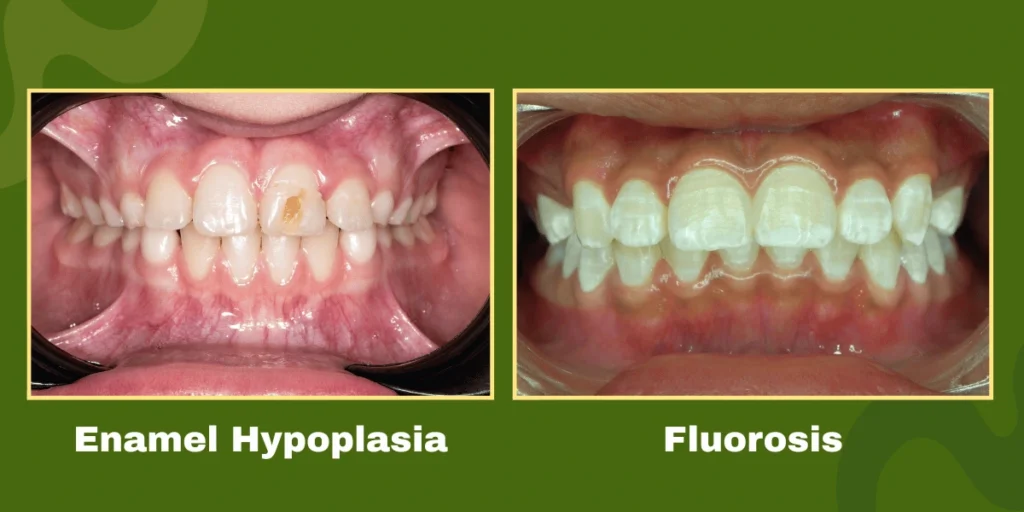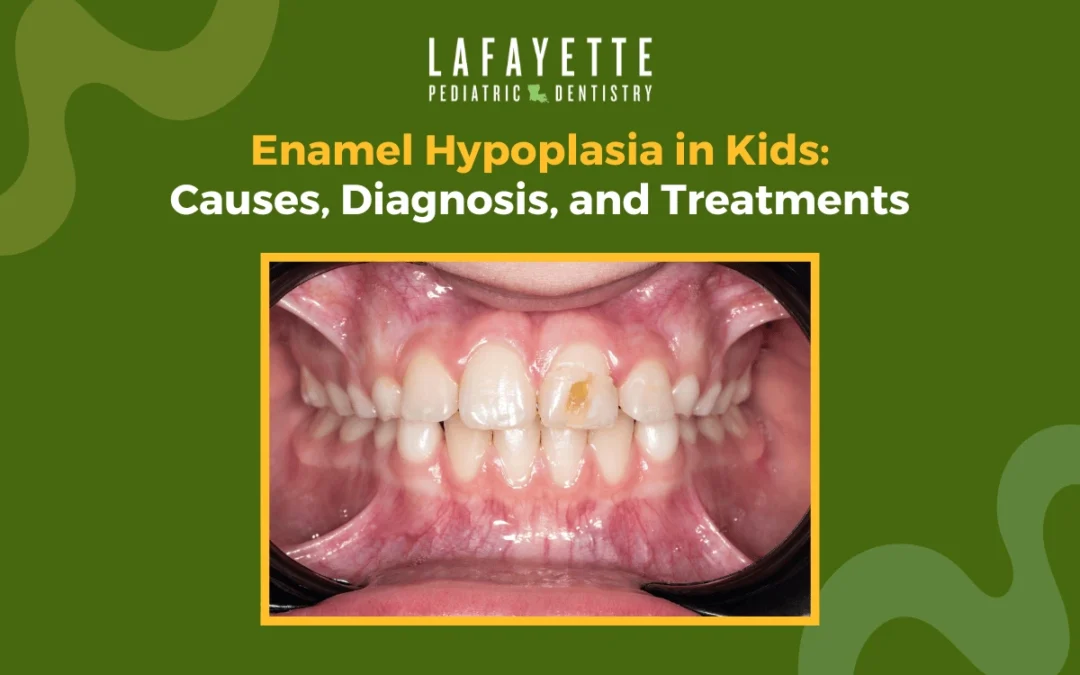When you notice unusual white spots or discolored patches on your child’s teeth, it can definitely be a little worrying.
One condition that might be responsible for these changes is enamel hypoplasia, a dental condition that affects how the enamel, the hard outer layer of the tooth, forms.
While it’s not unusual in children, we’ve seen a lot of parents here in Acadiana who haven’t heard about it.
Most parents don’t learn about enamel hypoplasia until a dentist points it out and explains what’s going on with their child’s teeth.
Let’s walk through what this condition actually is, why it happens, and what treatment options are available.
What Exactly is Enamel Hypoplasia?
Enamel hypoplasia happens when the enamel on a child’s teeth doesn’t form properly. In some areas, it may be thinner than it should be or even missing entirely.
Enamel is the hard, protective shell on the outside of the tooth, and actually the hardest substance in the human body, so any defects in how it develops can leave the tooth more exposed and vulnerable.
You’ll usually notice it as white spots on the teeth, but depending on the severity, those spots might also look yellow or brown. Sometimes it’s just a few small white patches that are easy to miss.
In more noticeable cases, there might be pits or grooves in the tooth surface, or even spots where the enamel looks chipped or is completely missing.
The concern with enamel hypoplasia isn’t just cosmetic, though we understand that appearance matters. The bigger issue is that enamel hypoplasia can make teeth more prone to cavities, sensitivity, and other dental problems over time if it’s not addressed.
Without a strong enamel layer, it’s easier for bacteria to cause damage, and temperature changes from hot or cold foods can be uncomfortable.
Read more: Why Are My Child’s Teeth Turning Yellow? Common Causes of Tooth Discoloration in Kids
Does Enamel Hypoplasia Run in Families?
This is one of the most common questions we get from parents here in Lafayette, and the answer is yes, enamel hypoplasia can definitely be hereditary. If you or your partner had this condition as a child, there’s a higher chance your little one might have it too. It’s not a guarantee, but genetics can definitely play a part.
Certain medical conditions such as low birth weight, prematurity, or cerebral palsy can result in disturbance to the development of tooth enamel, resulting in hypoplasia.
A slight correlation between frequent illness/antibiotic usage in infancy and enamel hypoplasia has also been found in scientific literature.
Nutrition is a big factor too, and this is something parents can actually influence. For example, a deficiency in vitamin D during important stages of development can increase the chances of enamel issues.
This is why we always stress the importance of a well-balanced diet during pregnancy and those early childhood years.
It’s worth noting that while a significant number of cases of enamel hypoplasia can happen to any child without any of the aforementioned conditions or risk factors.
It is therefore important to stay up to date on your child’s dental checkups so that enamel hypoplasia can be detected and addressed early.
Read more: How Do Genetics Affect Your Child’s Teeth? What You Can and Can’t Control
When Does This Actually Happen?
This condition can actually start developing while a child is still in the womb. The enamel on baby teeth begins forming during pregnancy, so factors affecting the mother during this time can potentially impact the developing teeth.
But it’s not just limited to pregnancy. This condition can also show up during the development of both baby teeth and permanent teeth.
For permanent teeth, this development continues well into childhood, which means there are multiple windows where this condition can develop.
For example, we sometimes see kids whose baby teeth look normal, but when the permanent teeth come in, signs of enamel hypoplasia start to show.
How Can We Treat Enamel Hypoplasia in Kids?
Treating enamel hypoplasia really depends on the specific case. The approach we take is based on how severe the condition is, and not every child needs major treatment.
For mild cases, where there are just a few white spots or minor enamel loss, we usually focus on prevention and regular maintenance.
That might mean being extra careful with brushing and flossing, along with fluoride treatments to help strengthen the teeth and reduce the risk of decay.
If the appearance of the teeth becomes more of a concern or if the enamel loss is causing sensitivity or raising the risk of cavities, we have a few options to consider.
For moderate cases, tooth-colored resin bonding is a common choice. It involves applying a material that blends in with the tooth to fill in the weak spots and restore both look and function.
For more serious cases, we may recommend veneers or crowns. These are more involved treatments, but they can be really helpful when there’s significant enamel loss.
While we always try to be as conservative as possible with kids, these options can go a long way in protecting the teeth and helping the child feel more comfortable and confident.
It’s important to remember that the best treatment option depends on several factors, like your child’s overall health, age, how well they can handle dental procedures, the extent of the enamel loss, and how likely they are to face future dental issues.
What works well for one child might not be the right fit for another, which is why we always walk through the options with families and tailor the plan to each child’s needs.
Can We Prevent Enamel Hypoplasia in Kids?
The reality with enamel hypoplasia is that some aspects are completely out of our control. You can’t change genetics, and it’s not always possible to prevent every illness or complication that could affect how teeth develop.
But there are definitely steps parents can take to help lower the risk. Making sure your child gets good nutrition is one of the most important ways to support healthy enamel development. This really starts during pregnancy and continues through childhood while the permanent teeth are still forming.
It also helps to be aware of medications when you can. Some antibiotics and other types of medication can impact enamel development, so it’s a good idea to talk with your child’s pediatrician about any dental concerns when medications are prescribed.
Enamel Hypoplasia vs. Fluorosis
We hear from a lot of parents who confuse enamel hypoplasia with dental fluorosis, and it’s understandable why. Both conditions can cause white spots or discoloration on teeth, but they’re actually quite different.
Fluorosis happens when a child gets too much fluoride during the time their teeth are developing, and it causes changes in the enamel’s appearance. Enamel hypoplasia is more about enamel not forming properly in the first place.
One of the main differences is how the teeth look. Fluorosis usually shows up as more even, chalky-looking patches across several teeth, while enamel hypoplasia tends to cause more noticeable spots or areas where the enamel is missing.

Getting an accurate diagnosis from a trained professional is important because the treatment options can vary. We use various diagnostic tools and sometimes need to look at the pattern of affected teeth to determine which condition we’re dealing with.
If you think your child might have enamel hypoplasia, the best thing to do is get an evaluation from their dentist. This condition is manageable, and there are good treatment options that can help protect your child’s teeth and support their confidence as they grow.
If you have any questions about enamel hypoplasia or anything else related to your child’s dental health, or if you’d like to set up an appointment, feel free to reach out to our pediatric dental office in Lafayette.
We serve families throughout Lafayette, Broussard, Youngsville, and the greater Acadiana area, and we’re always here to help you navigate your child’s dental health journey.
